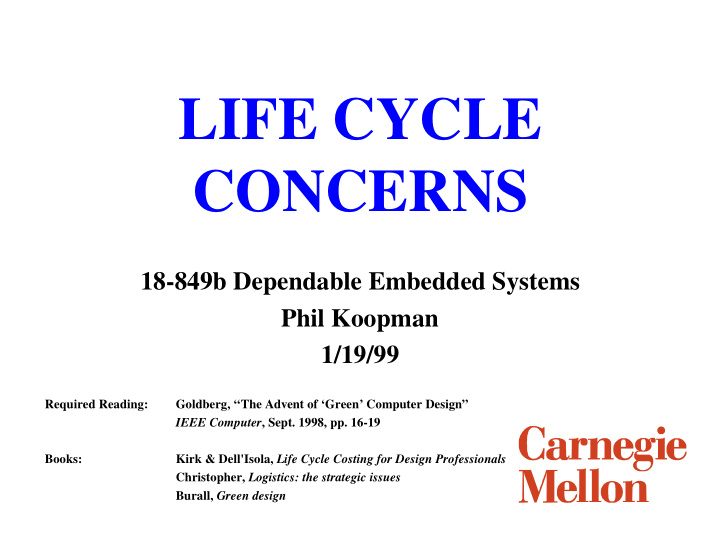



LIFE CYCLE CONCERNS 18-849b Dependable Embedded Systems Phil Koopman 1/19/99 Required Reading: Goldberg, “The Advent of ‘Green’ Computer Design” IEEE Computer , Sept. 1998, pp. 16-19 Books: Kirk & Dell'Isola, Life Cycle Costing for Design Professionals Christopher, Logistics: the strategic issues Burall, Green design
Maintenance and Reliability Manufacturing/ Ultra-Dependability Quality SYSTEM LIFE CYCLE PROFIT$ & End-of-Life BUSINESS Wearout & MODELS Retirement Design Process/ Market Shoddy Spares & VERIFICATION/ Customer VALIDATION/ Circumvention CERTIFICATION
Overview: Life Cycle N Introduction • “Dotted Line” relationship to technical areas N Key concepts • Green Design • Life cycle product/process engineering • Life cycle cost optimization • Logistics N Tools / techniques / metrics • Mostly business metrics available N Conclusions & future work 3
Life Cycle View -- Not Just Development N Optimize considering all phases of product life • Compare to “development,” which ends when product ships NEED/ OPPORTUNITY CONCEPT RETIREMENT/ DEVELOPMENT DISPOSAL MANUFACTURING PRODUCT UPGRADES PROCESS DESIGN DESIGN SUPPORT/ PRODUCTION MAINTENANCE DEPLOYMENT 4
“Life Cycle Cost” N This is the economic/financial view • Optimize total cost of ownership – Key factors: purchase cost, energy, maintenance, upgrades, administrative, debt service, staffing (degree of automation), downtime (opportunity cost) • Optimize total cost to society – Disposal costs, infrastructure costs N People’s behavior is a problem • Consumers are impatient, and have cash flow problems – Value low purchase price even if life cycle cost is high • People are modeled to behave to maximize utility – But, may not have up-front money to invest – But, may not have any personal incentive to reduce societal costs 5
Logistics N Keeping supplies flowing • By type of item: – Manufacturing components – Finished goods – Spare parts • By activity: – Delivery – Inventory • Optimize using linear programming/flow optimization N Problems with support • Not perceived to delivery functionality (“overhead” cost) • Costs more to play catch-up after product is fielded 6
“Life Cycle Assessment” N This is the “Green Design” interpretation • Analyze product design with view to ultimate impact of scrapping, disposal, or consumption • ISO 14000 series -- ISO 14040 Life Cycle Assessment N Impact on embedded systems • IBM estimates that discarded computers will occupy 2 million tons of US landfill space by 2000. [Goldberg98] • Use low power design – Reduce energy/resource consumption – Reduce battery requirements (disposable & rechargeable) • Design for access/separability/longevity – Dis-assembly for recycling – Ready repairability – Better upgradability 7
Tools / Techniques N CAD Tools for Green Design • Tracking materials through disposal • Design for dis-assembly as well as assembly • “Spreadsheet” approach to tallying total cost to environment N Classical logistics optimization • Network flow problem/linear programming 8
Relationship To Other Topic Areas N Not really “related” to topic areas as much as an overlay concept • But, must keep life cycle optimization in mind for each area N Profits & Business Models • Want to optimize business profits over various life cycles – Product itself – Manufacturing process – Support/logistics cost • Business issue in terms of maximizing own profit at cost to others – Cost of pollution, government subsidy of technologies, resource depletion – Usual solution is for government to create taxes ( e.g. , with freon) 9
Conclusions & Future Work N “Life Cycle” has many meanings • Most mature areas are life cycle cost analysis and logistics • Green Design is a sub-area to emphasize ecological costs N This is a big, broad, nebulous area -- it’s not feasible to cover absolutely everything • Writeup will discuss general concepts • Give a few pointers to a few good starting points; not exhaustive • Not a lot of hard-core engineering papers available – Mostly management & economics – Green Design is an exception -- receiving engineering attention 10
PAPER: “Green” Computer Design N Cool idea: “Self-dismantling computer” N Green design is good; but there are obstacles • Reduce resource usage, energy usage, manufacturing waste • Cost of recycling can exceed cost of building new • Dynamic tension between building a upgradable product and making profit on selling replacement products N No key technical contribution -- it’s a high-level “popular” discussion 11
Recommend
More recommend